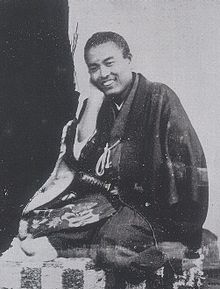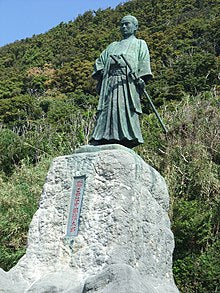
Nakaoka Shintarō
Share
Nakaoka Shintarō (中岡 慎太郎, born May 6, 1838 at Tosa estate and died of wounds after an assault at the age of 29 on December 12, 1867 in Kyoto) was a Japanese samurai of the Bakumatsu period (1854-1867) who was close to Sakamoto Ryōma in the anti-shogunate movement.
Nakaoka Shintarō Biography

A native of the Tosa estate (present-day Kitagawa village in Kōchi prefecture), Nakaoka was the son of a provost marshal. In 1861, he entered the Takechi Hanpeita Academy where he studied swordplay.
He was one of the founding members of the Tosa Kinno-tō, an ishin shishi paramilitary organization created by Takeichi to participate in the anti-foreign movement.
After the coup of September 30, 1863, which led to the suppression of anti-foreign factions, he fled to the Chōshū estate where he was welcomed by like-minded nobles such as Sanjō Sanetomi.
In 1864, he participated in an abortive plot to assassinate Shimazu Hisamitsu and fought with Chōshū forces during the Hamaguri Gate Rebellion and the bombardment of Shimonoseki. Later that year he worked for the Kaientai trading company founded by Sakamoto Ryōma and negotiated Sanjō Sanetomi's support for the establishment of the Satsuma-Chōshū alliance.
In March 1867, he returned with Sakamoto Ryōma to the Tosa estate from which they came to negotiate a similar alliance between Tosa and Satsuma.
In June, he began negotiations to expand the new alliance to include Chōshū and the Hiroshima estate, but the project was not pursued when the shogun Tokugawa Yoshinobu officially handed over power to the emperor.
Realizing that a civil war was imminent, Nakaoka returned to Tosa and founded the Rikuentai militia in July, based on the model of the Kiheitai of the Chōshū estate. On December 10, 1867, he traveled to Kyoto to talk with Sakamoto Ryōma, but was murdered with him when unknown assailants attacked their lodgings (Ōmiya incident).
Sakamoto is killed immediately and Nakaoka is seriously injured and dies two days later, without being able to figure out who these mysterious assailants were. Initial investigative reports accused members of the Shinsen gumi (a shogunal militia) of the murders of Ryōma and Nakaoka.
The leader of the Shinsen gumi, Isami Kondō, was notably executed on this basis. However, another group that supported the shogun, the Kyoto mimawarigumi group led by Imai Nobuo claimed responsibility for the murder in 1870.
Although Sasaki Tadasaburō (alleged leader of the operation) and Imai Nobuo were accused, the real murderer of Ryōma was never tried in court.

His grave is at the Kyōto Ryōzen Gokoku-jinja in Higashiyama-ku Ward in Kyoto. He was posthumously elevated to the 4th court rank by the Meiji emperor in 1891.
There is a large bronze statue of Nakaoka Shintarō at the Murotomisaki Lighthouse located at Cape Muroto in his native Kōchi Prefecture, and another (with Sakamoto Ryōma) at Maruyama Park in Kyoto.

